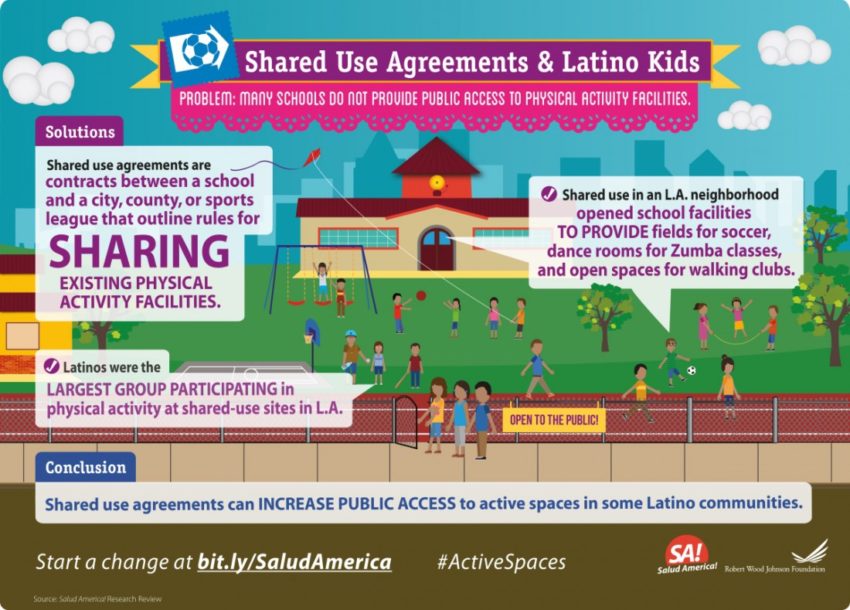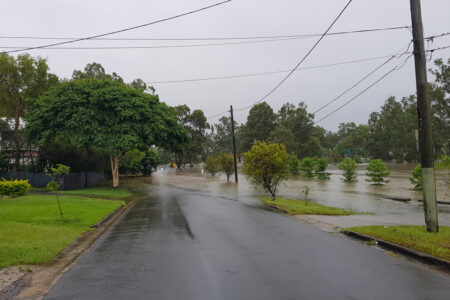
Share On Social!
This is part of our Active Spaces & Latino Kids: A Research Review »
The goal to increase access to schoolyards after school
One of the goals for Healthy People 2020 is to increase the access to school physical activity facilities during non-school hours, with a current goal of having 31.7 percent of U.S. schools providing access by 2020.11
The previous target, from Healthy People 2010, was to have 50 percent of schools allowing access by 2010; however, data showed that no progress was being made so the goal was revised.31 In fact, fewer schools provided access to their physical activity facilities in 2006 (29%) than the baseline in 2000 (35%), although the difference was not statistically significant.
Before 2010, the School Health Policies and Programs Study (SHPPS) sought to assess the progress made toward the Healthy People 2010 objective by analyzing the proportion of U.S. schools providing access to physical activity spaces and facilities in 2000 and 2006.12
Among the schools that reported having physical activity facilities, approximately two-thirds provided access to children and adolescents during non-school time for community-sponsored sports activities, but only one-third provided access for community-sponsored classes, lessons, or supervised open gym/free play.
These percentages did not change significantly between 2000 and 2006. Urban communities were more likely than non-urban communities to have access to schools for supervised open gym/free play, and high-poverty areas were more likely than low-poverty areas to have access to schools for unsupervised use of outdoor facilities.
The effectiveness of shared use agreements
Still, some Latino communities have successfully increased access to physical activity facilities through the implementation of SUAs—formal contracts between entities that outline the terms and conditions for sharing public facilities for physical activities.
In particular, great strides have been made in the state of California, which is 38.1 percent Latino. In Los Angeles County (47% Latino), the Joint Use Moving People to Play (JUMPP) Task Force was initiated in 2010 to promote physical activity by implementing system and environmental changes, including SUAs with schools.32
The JUMPP Task Force worked with seven schools districts with high childhood obesity burdens and helped establish SUAs at several schools. Data were collected on the effort from 2010-2012. One of the key successes of the SUAs was the implementation of structured physical activity programs for adults and children: Community use of shared-use sites was found to be significantly higher when structured physical activity programs were offered compared with when no program was offered.
Shared-use sites offering programs attracted 16 times the amount of community members as sites offering no program. Additionally, adult-focused programs appeared to help attract children to the sites, as parents often brought their children with them to sites during shared-use hours. Overall, among the users of the shared-use sites, Latinos represented the largest group engaging in moderate-to-vigorous physical activity.
Overcoming liability concerns for shared use
Studies suggest that liability concerns are among the key barriers to providing community access to school physical activity facilities.13,33,34
SUAs and other agreements provide liability protection for school districts that open their facilities for public use, but school administrators are often unaware of the protections afforded to them by such agreements.
In a survey sent to 1,714 public schools in underserved communities in 46 states (approximately 30% of which in Latino communities) and completed by personnel from 360 eligible schools (21% response rate), 82.2 percent of respondents indicated that they were somewhat-to-very concerned about the liability associated with recreation- or sport-related injuries occurring on school property during non-school hours.34
Among the schools that did not allow access to school grounds for recreational purposes, 91 percent stated that liability was somewhat-to-very concerning, and 85.7 percent desired stronger laws to protect schools from liability. Interestingly, only 41 percent of respondents were familiar with laws that limited the liability of public schools in their state. The majority of respondents believed that stronger legislation was needed, regardless of their familiarity with state law or whether their school had been subject to a previous liability claim.
Among the schools that reported having formal legal agreements in place for the use of their facilities during non-school hours, only 44.8 percent of respondents perceived the protections to be adequate and only 14.6 percent would agree to sharing their facilities with other groups in the absence of a formal legal agreement. Although the low response rate limits the generalizability of the findings, no demographic differences were found between responder and nonresponder schools.
Although liability is a concern among school administrators, studies have found that schools would be reasonably protected from liability associated with providing facility access to the community.35,36
In a systematic review of the legal rules associated with land usage in the 50 states and the District of Columbia, investigators sought to identify the potential liability for schools that provide access to their grounds for recreational activity during non-school hours. Data suggest that public schools in all states are protected by some form of sovereign or governmental immunity, recreational use statutes, or limits on tort damages. Although some liability risk remains in certain circumstances, the investigators concluded that the risks to schools do not outweigh the benefits of providing facility access to children who may be at risk of obesity.35
Other studies have evaluated the protections afforded to schools by recreational user statutes.
One review revealed that statutes from 42 states were potentially applicable to schools, although many lacked uniformity and well-defined descriptions of covered activities.36 Among the 42 states, most (82%) statutes used broad terms to define the activities for which schools would not be held liable and none referenced indoor facilities specifically.
For example, in states with large Latino populations, language to describe activities for which schools would be protected from liability include “winter sports” (California), “enjoying nature” (Texas), “recreational activities” (New Jersey and New Mexico), and “exercise” (Arizona), which may be difficult to interpret. Only a few states indicate specific activities such as “bicycling” (Colorado, New York, and Texas) and rollerblading or rollerskating (Colorado, New Jersey).
Because such broad terminology would require interpretation by the courts, it could potentially expose schools to liability. As such, including uniform and specific provisions for all relevant recreational and physical activities in state laws may better protect schools and encourage them to share their facilities during non-school hours.
These studies demonstrate a need for increased awareness of existing statutory protections afforded to schools and development of future policies that better clarify the terms of these protections (e.g., the specific activities covered under the statutes).
All states have some form of immunity that protects public entities from liability and most have some form of statute that allows for use of public facilities by the community; however, not all statutes provide for the joint establishment or shared use of school property/facilities.37,38 Recently, lawmakers in Arizona and Ohio enacted legislation that clarifies liability issues and provides greater liability protections to schools that implement SUAs.39,40
School districts considering a SUA should become aware of their state laws on shared use.
ChangeLab Solutions has compiled related laws in all 50 states, although some of the laws may have been updated since the original data were compiled.
Other barriers to shared use
Funding and staffing also are among the top barriers to providing access to schoolyards for Latino children.
In a survey of directors of 44 recreation centers in San Diego County (32.5% Latino), 54 percent indicated “inadequate staffing” and 39 percent indicated “funding” as primary barriers to offering physical activity programming for youth.41 Another survey of school representatives involved in 18 SUAs in Los Angeles County reported that approximately 50 percent of respondents noted staffing issues as a main concern.42
Overcoming barriers to staffing for shared use
Partnerships through SUAs can overcome these barriers by sharing costs and staffing.43–45
For example, for the SUA established at the Cajon Valley Union Elementary School District in San Diego (25.6% Latino), each partner who uses school facilities provides their own staffing, supervision, and security, and is responsible for operational costs associated with their programming. The school district is responsible for staff and costs associated with facility maintenance.44 Staff turnover was a major challenge for the Healthy High Desert SUA in Adelanto, Calif. (58.3% Latino). To overcome this barrier, the city and school district applied for additional grants and recruited staff with experience and genuine interest in making the SUA work.14
Increased support and feedback from all stakeholders may increase the use of SUAs in underserved communities.
Despite the challenges associated with establishing SUAs in underserved communities, some barriers may be overcome if all stakeholders have a voice in developing the agreement and its resulting programs.
School districts, planners, community members, public health officials and other partners should be involved early in the process to ensure that the needs of all stakeholders are met. To increase participation among the Latino community, language barriers must be considered; for example, bilingual facilitators and Spanish-language materials should be available at all stakeholder meetings.
Several case studies have cited cooperation among stakeholders as the main contributor to the success of a SUA.
In a case study of a pilot SUA between the Department of Parks and Recreation (DPR) and an urban high school in Honolulu, Hawaii, increased support of school administrators and feedback from school and DPR staff, students, and community members facilitated the development of a successful physical activity program in the community.
Specific factors were noted as being instrumental in the program’s success, including: trust and effective communication among school administration, faculty and DPR staff; willingness of school administrators to accommodate project needs, such as office space, communication systems, storage space for equipment, and administrative assistance; feedback from students, faculty, staff, and community members about the type and timing of activities; and targeted recruitment based on feedback.
Although this study involved a high school with a very small Latino population (1.1%), the majority of students enrolled in the school are of ethnic minority background and lower socioeconomic status. Therefore, findings may offer strategies that could be successfully applied in other underserved areas of the country.43
In the Fruitvale neighborhood (46% Latino) of Oakland, Calif., the success of a SUA has been attributed to strong relationships between stakeholders. Public officials, school administrators, and community members have collaborated with the Unity Council, a nonprofit community development agency, to offer evening sports leagues on school grounds for more than 500 youth. Outreach was critical to engaging the community and instilling a sense of ownership in the program.44
A program in the Boyle Heights (94% Latino) and Pico-Union (92% Latino) neighborhoods in Los Angeles, Calif., called Joint Use Generating Activity and Recreation (JUGAR), brought together community stakeholders and public agencies to increase access to public space, such as a walking path and sports field, for physical activity.
Effective engagement of school administrators and community partners ensured that all stakeholders understood the needs of the community and the terms of the agreement, which led to JUGAR establishing joint use partnerships.14
More from our Active Spaces & Latino Kids: A Research Review »
- Introduction & Methods
- Key Research Finding: Access to active spaces
- Key Research Finding: Shared use agreements (this section)
- Key Research Finding: Unpleasant neighborhood characteristics
- Key Research Finding: Park maintenance and safe streets
- Key Research Finding: Marketing of physical activity
- Policy Implications
- Future Research Needs
References for this section »
(31) US Department of Health and Human Services. Healthy People 2010 Final Review http://www.cdc.gov/nchs/healthy_people/hp2010/hp2010_final_review.htm (accessed Feb 18, 2013).
(32) Lafleur, M.; Gonzalez, E.; Schwarte, L.; Banthia, R.; Kuo, T.; Verderber, J.; Simon, P. Increasing Physical Activity in under-Resourced Communities through School-Based, Joint-Use Agreements, Los Angeles County, 2010-2012. Prev. Chronic Dis. 2013, 10 (6), E89.
(33) Evenson, K. R.; McGinn, A. P. Availability of School Physical Activity Facilities to the Public in Four US Communities. Am. J. Heal. Promot. 2004, 18 (3), 243–250.
(34) Spengler, J. O.; Connaughton, D. P.; Maddock, J. E. Liability Concerns and Shared Use of School Recreational Facilities in Underserved Communities. Am. J. Prev. Med. 2011, 41 (4), 415–420.
(35) Baker, T.; Masud, H. Liability Risks for after-Hours Use of Public School Property to Reduce Obesity: A 50-State Survey. J. Sch. Health 2010, 80 (10), 508–513.
(36) Spengler, J. O.; Carroll, M. S.; Connaughton, D. P.; Evenson, K. R. Policies to Promote the Community Use of Schools: A Review of State Recreational User Statutes. Am. J. Prev. Med. 2010, 39 (1), 81–88.
(37) National Policy and Legal Analysis Network To Prevent Childhood Obesity. Fifty-state scan of laws addressing community use of schools Available at: http://changelabsolutions.org/sites/default/files/documents/JU_StateSurvey_FINAL_2010.03.19.pdf (accessed Dec 20, 2012).
(38) ChangeLab Solutions. State memos on shared use liability http://changelabsolutions.org/publications/liability-schools-50-states. Available at: (accessed Mar 13, 2015).
(39) American Heart Association. Building Bridges Between Schools and Communities. Available at: http://www.heart.org/HEARTORG/Advocate/VoicesforHealthyKids/ActivePlaces/Building-Bridges-between-Schools-and-Communities_UCM_470443_Article.jsp#.Vk38TnarS7 (accessed Nov. 19, 2015).
(40) American Heart Association. Ohio lawmakers make it easier for public to use school fields, facilities after school hours. Available at: http://blog.heart.org/ohio-lawmakers-make-easier-public-use-school-fields-facilities-school-hours/ (accessed Jan 1, 2015).
(41) Moody, J. S.; Prochaska, J. J.; Sallis, J. F.; McKenzie, T. L.; Brown, M.; Conway, T. L. Viability of Parks and Recreation Centers as Sites for Youth Physical Activity Promotion. Health Promot. Pract. 2004, 5 (4), 438–443.
(42) Burbage, L.; Gonzalez, E.; Dunning, L.; Simon, P.; Kuo, T. Building Mutually Beneficial Partnerships to Improve Physical Activity Opportunities through Shared-Use Efforts in under-Resourced Communities in Los Angeles County. Prev. Med. (Baltim). 2014, 67, S4–S9.
(43) Maddock, J.; Choy, L. B.; Nett, B.; McGurk, M. D.; Tamashiro, R. Increasing Access to Places for Physical Activity through a Joint Use Agreement: A Case Study in Urban Honolulu. Prev. Chronic Dis. 2008, 5 (3), A91.
(44) California Pan-Ethnic Health Network. Unlocking the playground: Achieving equity in physical activity spaces. Available at: www.cpehn.org/pdfs/Joint Use Brief.pdf (accessed Nov 15, 2012).
(45) Public Health Law and Policy. Opening school grounds to the community after hours: A toolkit for increasing physical activity through joint use agreements. Available at: www.phlpnet.org/healthy-planning/products/joint_use_toolkit (accessed Nov 15, 2012).
Explore More:
Healthy Neighborhoods & CommunitiesBy The Numbers
1
Supermarket
for every Latino neighborhood, compared to 3 for every non-Latino neighborhood



